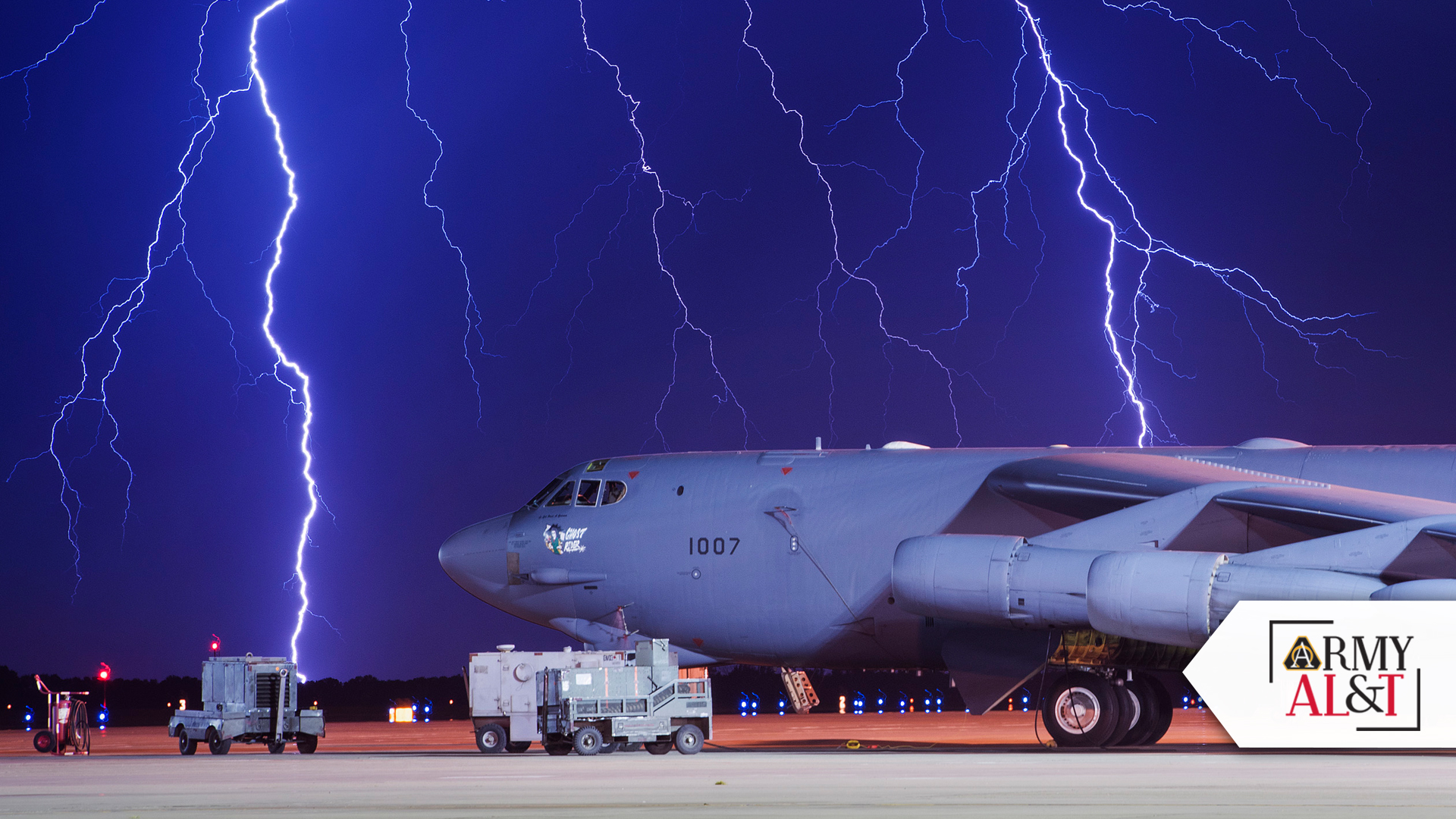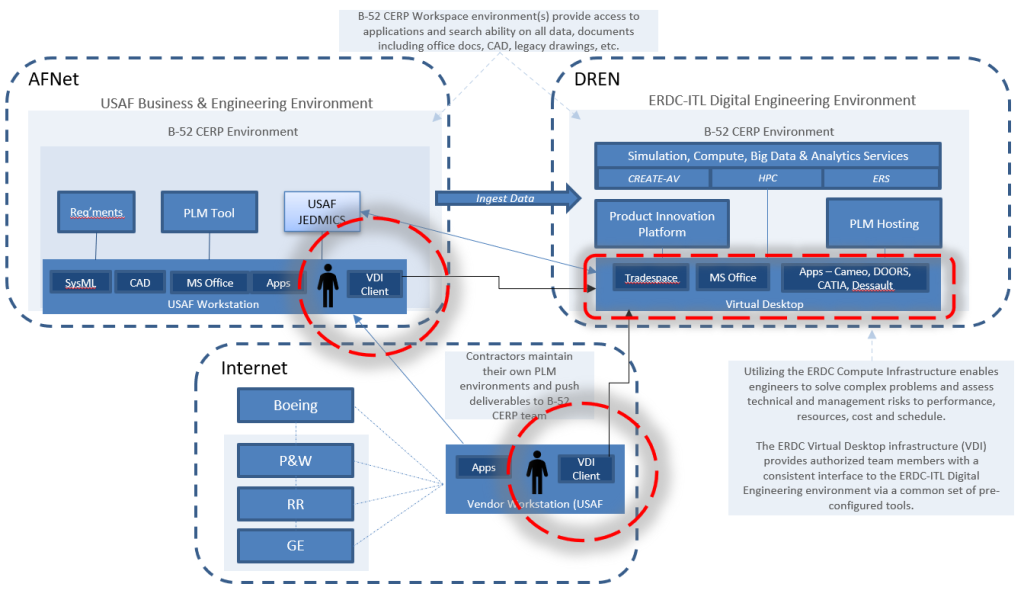
WEATHER THE STORM: Lightning strikes behind a B-52H Stratofortress at Minot Air Force Base, North Dakota, Aug. 8, 2017. In a conventional conflict, the B-52 can accomplish strategic attacks, close-air support, air interdiction, offensive counter-air and maritime operations. (Photo by Senior Airman J.T. Armstrong, U.S. Air Force)
Joint effort between the ERDC and the U.S. Air Force means the B-52 will fly on
by Megan Holland
First introduced in 1955, the Boeing B-52 aircraft has a rich history. The success of a recent effort led by the U.S. Army Engineer Research and Development Center (ERDC) Information Technology Laboratory (ITL) to facilitate the selection of an optimal replacement for the aging, original engines—deemed unsustainable within the next decade due to a disappearing supply chain—means that legacy will continue.
“The Air Force plans to use the legendary B-52 Stratofortress bomber aircraft through the 2050s and aims to keep the aircraft operational by procuring new engine systems that will replace the engines currently in use across the fleet of aircraft,” said ITL Supercomputing Research Center (SRC) Chief Operating Officer York Yarbro. “The last B-52 rolled off the production line in 1962, and inventory issues were threatening to ground the fleet.”

ENGINE CHECK: A U.S. Air Force B-52H Stratofortress bomber assigned to the 307th Bomb Wing goes through an engine check June 24, 2021, at Barksdale Air Force Base, Louisiana. Eight Pratt & Whitney TF33 engines power the B-52H to give it the capability of flying at high subsonic speeds. (Photo by Senior Airman Kate Bragg, U.S. Air Force)
|
Fun Facts about the B-52 Bomber Plane by the United Service Organizations (USO)
|

OUT AT SEA: A U.S. Air Force B-52 Stratofortress, from the 5th Bomb Wing at Minot Air Force Base, North Dakota, breaks away after receiving fuel from a U.S. Air Force KC-135 Stratotanker from Royal Air Force Mildenhall, England, over the Mediterranean Sea, April 9, 2018. (Photo by Airman 1st Class Benjamin Cooper, U.S. Air Force)
PRESERVING THE FUNDAMENTAL
In response, the Air Force developed the Commercial Engine Replacement Program to identify a replacement for the legacy engines on the aircraft and, ultimately, extend the B-52 life cycle. The goal was to develop an ecosystem that would allow the use of a digital twin approach to model-based systems engineering (MBSE) and permit a quicker turnaround when conducting evaluations and down selects. The Air Force also wanted the new engines to be so maintainer-friendly and efficient that they would pay for themselves within 10 years.
“Faced with the challenge of establishing a digital infrastructure that could support rapid evaluations of proposed prototypes prior to physical development, the Air Force turned to ITL,” Yarbro said. “We had experience in designing and deploying virtual ecosystems that support pre- and post-processing of design activities, as well as experience with configuration and version control for fast-running analysis tools. ITL, primarily through the SRC, brought to bear the ability to integrate a number of tools and configure them for the unique requirements of this effort.”
MBSE is a method that uses modeling to support system requirements, design, analysis, verification and validation. A foundation of digital engineering for the Air Force effort begins in the conceptual design phase and continues through development and late life cycle phases. The method is most frequently used when developing and managing systems requirements and enables quicker evaluation of alternative concepts, allowing more models to be evaluated for better informed decisions.
“Once the models become physical artifacts, MBSE data and information is still used to manage the life cycle of the device, vehicle, etc.,” said Yarbro. “Coupling MBSE with modern data analytics and computing capabilities is viewed by the Air Force as the transformational opportunity of digital engineering, which is part of their Digital Transformation Strategy.”
Introducing digital twins, or virtual models, to the MBSE acquisition design and development phase further increases the number of models that can be developed and evaluated, ultimately boosting the likelihood of success. Digital twins can also be used throughout the development, production, operations and maintenance phases for accelerated risk assessments, predictive maintenance and more.
“The overall impact from the use of digital twins is improved reliability, availability, performance and productivity and, ultimately, better financial decision making,” said Yarbro. “The ITL approach to building the ecosystem could be leveraged by a wide-range of MBSE applications to design and build their models to exchange data, just as was done for the B-52 Commercial Engine Replacement Program effort.”

EYES ON ENGINES: Airmen assigned to the 307th Maintenance Squadron inspect the running engines of a B-52 Stratofortress for leaks on Barksdale Air Force Base, Louisiana, June 29, 2017. The engine run is one of the final parts of a phase inspection of the bomber and multiple eyes are needed. (Photo by Master Sgt. Dachelle Melville, U.S. Air Force)
ELEMENTS FOR SUCCESS
The ITL team established a digital ecosystem that uses virtual desktop interface and virtual machine capabilities within the SRC to deliver product life cycle management tools and complementary computer-aided design and visualization toolsets in a familiar user interface. These resources were then leveraged by the Air Force to further combine and analyze data while developing inputs to high-performance computing resources to conduct intensive, higher-fidelity modeling of prototypes and the effects of those prototypes on the aircraft.
“According to the Air Force, the replacement engine needed to maintain performance, improve fuel efficiency by 20 to 40 percent, work well with the B-52’s unique design, and overcome a variety of additional obstacles,” Yarbro said. “They also needed the engines to be compatible with the aircraft’s existing systems and sustain current mission capabilities.”
Engine makers were confident their commercial power plants could meet the requirements for performance but felt it would be difficult to integrate their commercial engines with the B-52 and adapt them for military use. That meant the digital engineering platform developed by ITL was critical to providing vital data at the speed required to allow the trade-off analysis and decision-making necessary to achieve the program’s acquisition milestones—and it did just that.
“In the early stages, the effort focused on data, but over time, additional requirements evolved as essential to improving the value and usefulness of the data,” Yarbro said. “The capability we developed is highly valued by our Air Force partners, and this is a major success story for ITL. The customer was able to use a functional digital ecosystem in a much shorter time frame than they originally anticipated, enabling them to make their decisions faster.”

DIGITAL TRANSFORMATION: A diagram from the 2018 Department of Defense Digital Engineering Strategy depicts the use of models as an authoritative source of truth. The strategy’s first goal is to “formalize the development, integration and use of models to inform decision making.” (Graphic by DOD and USAASC)
CONCLUSION
The B-52 Systems Engineering Group believes the project conservatively saved the Air Force an estimated $10 million, and there are plans to expand the effort to bring the entire B-52 system program office into the environment as a standard tool. For Yarbro, whose father is retired from the U.S. Air Force and once worked on the electronics and communications for the B-52 aircraft, the work has been both rewarding and deeply personal.
“One of my earliest memories is my father taking me to the base where he was stationed, and I saw B-52s taking off and landing,” said Yarbro. “I was fascinated then, and I am probably even more fascinated now. It has been a blessing to even be a small part of this project and to feel a stronger connection with him.”

ERDC CONTRIBUTIONS: An overview diagram visually depicts the U.S. Army Engineer Research and Development Center’s role and contributions to the B-52 effort. (Graphic by ERDC and USAASC)
For more information, check out the Power of ERDC Podcast episode 17, “Modernizing the B-52 Through Supercomputing,” go to poweroferdcpodcast.org or contact Megan Holland at megan.m.holland@erdc.dren.mil.
MEGAN HOLLAND is the communication officer for the U.S. Army Engineer Research and Development Center (ERDC) Information Technology Laboratory. She has an MBA with an emphasis in marketing from Mississippi State University and a Bachelor’s in English and writing from Mississippi College.


